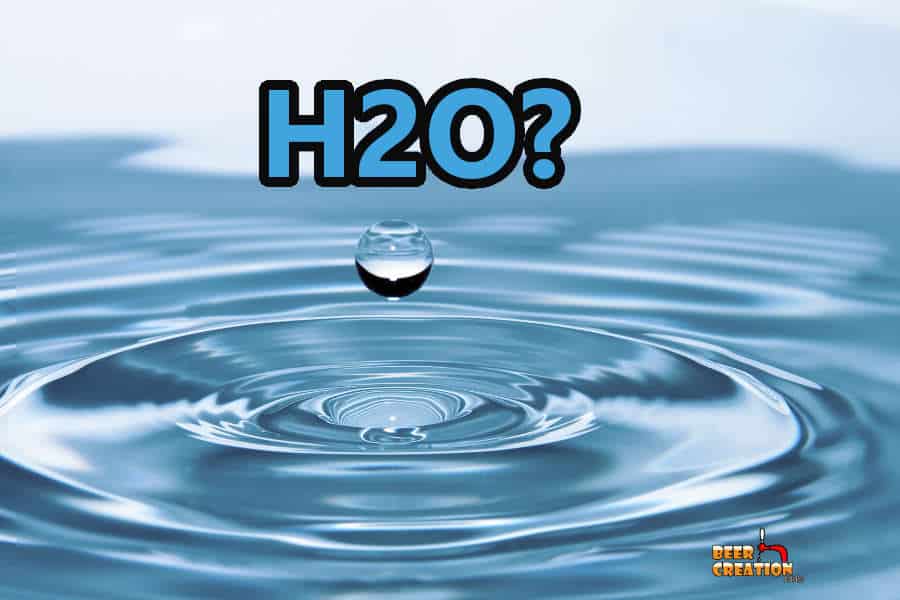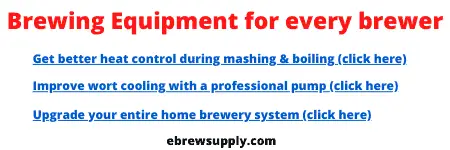Beer is essentially made of three ingredients, grains, hops, and water with a special helper doing all of the magic, yeast. Of the ingredients, water is the most difficult for a new brewer to gauge the quantity of, but it’s easier to figure out then you may have first thought.
So how much water do you really need for homebrewing?
For mashing, you should aim to use about 1.25 quarts/pound (1.2 liters/kg) of strike water. If sarging beer, a good estimate for how much sparge water you need is to multiply your strike water by 1.5. When boiling your wort you’ll lose about 20-40%, so start with that much in additional liquid.
There’s actually more to water quantities in beer than these simple guidelines, and this is what I’m going to explore in the rest of the article. By the end of it, you’ll know everything you’ll ever need to know about water and brewing.
Water for different types of brewing

You may be reading this article at a certain point along your brewing journey, so some of the information may be more applicable to your situation than other pieces. I say “journey” because most brewers really get hooked on this hobby and so their brewing techniques develop, improve and even change over time. So, your use and understanding of water in brewing has to as well.
There are three main methods of brewing which I’m going to cover in this article and they are extract-based brewing, all-grain brewing, and Brew In A Bag (BIAB) brewing. For recipes that rely on malt extract, you don’t need to concern yourself with Mashing or Sparging, although you’ll find it interesting to read these sections. For both all-grain and BIAB brewers, you should find everything you are looking for in this article from mashing water quantities, through sparging amounts and into boil quantities.
Mashing
Just in case you are unclear, mashing is a very important process which many all-grain and BIAB brewers will be familiar with and it’s the very first stage in brewing. In this process, we are treating our crushed malted grains in order to encourage natural enzymes present inside them to convert starch into fermentable sugar. This is done soaking the crushed grains in water and holding it at about 146-150°F (63-66°C) for up to an hour.
The amount of water we need, known as strike water, depends on how much grain we are dealing with and the level of evaporation we expect to have (although this is a lot less than in later phases.)
Strike water
Strike water refers to the brewing liquor, or treated water which is used during the mashing stage of brewing. Basically it is the heated water which you pour over your grains in the mash tun or vessel you’ll be mashing in.
You can use almost any water from any source which is drinkable and doesn’t have any contaminants in it. So, tap water is fine, rainwater probably should be avoided.
For more advanced brewing, there are two main things you can do in order to improve the quality of your strike water further. I say improve because the strike water is what makes up the majority of your wort and you really want to get the best possible quality of water you can to make the most of your beer.
So, those two things are removing chloramines and ensuring the correct calcium content in the water. Honestly, if you are a fairly new brewer I wouldn’t worry about this for the first few batches, but over time you may want to play around with this especially if you are relying on your local municipal water supply.
Removing Chloramines
By speaking to your local water board and getting a report you can confirm that they, like many other local authorities, add chlorine compounds to tap water to sanitize it.
It’s possible that if these chlorine compounds make it into your beer that they could cause some off-flavors known as chlorophenols. The taste is described as being kind of plasticy or like chewing on a band-aid/ plaster (seriously, who would know what that tastes like?)
To get rid of this risk you can use Campden tablets (link to Amazon deals) which have potassium or sodium metabisulfite in them and can almost instantly ‘kill off’ the chlorine when added to the strike water. The reaction can cause a bit of sulfur or eggy smell, but that’s going to go away during the boil so don’t worry too much about it.
One tablet, depending on the dose, can rid about 20 gallons (80l) of water at a time, so adjust your dose accordingly.
Calcium Content
Not only is it good for your bones, but calcium is also very beneficial for your beer. Having the right amount of calcium at the beginning of your brewing process can have lasting effects right up until you pour that beautiful beer weeks or months down the line.
Some of the benefits include:
- stabilizing the alpha-amylase enzyme during mashing
- limiting how many silicates and various astringents are extracted from grains
- improves how easy lautering is carried out
- improves the effectiveness of the hot break in boiling
- leads to less ‘color pick up’ during boiling
- helps limit haze and a gushing beer through oxalate ions forming into calcium oxalate and dropping out of suspension.
Speak to your local authority if you are using tap water to get an analysis of the calcium content or consider paying for a laboratory to do it. If there is no calcium at all in the water you want to use, then just add half an ounce (14 grams) of calcium chloride or 0.60 oz (17 grams) of gypsum per 10 gallons (38l) of water. That way you’ll hit the 100 parts per million (ppm) target and get all the benefits of the ideal quantity of calcium in your strike water.
Calculating the quantity of strike water
Grain Weight (lbs) | Water/Grain Ratio (qts/lb) | Grain temp. (°F) | Volume Strike Water (qts) | Temp. Strike water. (°F) |
10 | 1.25 | 65 | 12.50 | 169.4 |
15 | 1.25 | 65 | 18.75 | 169.4 |
20 | 1.25 | 65 | 25.00 | 169.4 |
25 | 1.25 | 65 | 31.25 | 169.4 |
30 | 1.25 | 65 | 37.50 | 169.4 |
10 | 1.25 | 75 | 12.50 | 167.8 |
15 | 1.25 | 75 | 18.75 | 167.8 |
20 | 1.25 | 75 | 25.00 | 167.8 |
25 | 1.25 | 75 | 31.25 | 167.8 |
30 | 1.25 | 75 | 37.50 | 167.8 |
Now, there is an abundance of calculators on the market, both webpages and apps, which will give you the amount and volume of strike water you need, but it’s a good idea to try and wrap your head around the formula behind it.
The main factors which determine just how much strike water you need for your mash are mash thickness and mash absorption. Depending on the mashing schedule and temperature steps you are going to be using, your mash thickness will be less than if you are going for an infusion mash.
Mash thickness really just refers to the ratio of water to grain and is usually measured in quarts to pound (liter to kilograms). For many brewers, this isn’t going to be a huge issue to worry about, but it can be affected by things such as annual changes in grains or a slightly different grain bill in a developing recipe.
As a good general guide, you should aim for about 1.25 quarts of water per pound of grain (1.2 liters).
Strike water temperature
We have previously seen, mashing should take place within a temperature range of 146-150°F (63-66°C) for around 60 minutes. However, you need to heat your strike water to a temperature about your target mashing temperature before you add it to your grains. This is especially true if using an isothermic mash tun with no capacity to increase the internal temperature.
What I mean to say is that as soon as your strike water mixes with the grains you are trying to mass it will lose thermic energy. This is because it becomes denser with the added solids in the mix. Depending on just how much liquid you have to solid, the temperature will reduce to a larger or lesser extent.
So, calculating the right temperature to start at is very important. If you are mashing in a conventional pot or stockpot, you can just add heat later, but this is nye on impossible to achieve in a mash tun without sacrificing cooler wort for more strike water.
Mash tun size
When choosing a dedicated mash tun in which to carry out your mash you need to not only consider the amount of strike water you’ll be using, but also the amount of grain you are mashing. By adding the strike water and the grain together you’ll get your total volume and this is the minimum space you need in your mash tun.
Also, you need to consider the next step, which is lautering. Depending on the method of sparging you will use (no sparge, batch sparge or fly sparging) you may need additional space in the mash tun to hold all of your additional sparge water from the hot liquor tank in one.
So, it’s always a good idea to get a bigger mash tun than you need for your present brewing needs, this gives you room to expand later. An additional 3-5 gallon capacity is a good general guide to how much extra space you’ll need on a basic 5-gallon yield brewing kit or recipe. For more details on everything to do with mash tun selection, see my dedicated article about this topic.
BIAB mashing
BIAB is a fairly new approach to homebrewing and it has several advantages as well as many differences to regular all-grain brewing. One of the most important is the amount of water you begin the brewing process with.
With extract brewing, it’s very common to top up your wort in the fermenter with as much as two or three gallons of water to hit your target yield. However, with BIAB you need to calculate the exact amount of water so that by the time mashing and boiling are completed, you have the right amount of wort for your target yield.
To do this you need to know several pieces of data to do with your ingredients and personal brewing setup.
- Total weight of grain bill (lbs)
- Total weight of hops (oz)
- Boil time (minutes)
- Mash Temperature (°F)
- Grain Temperature (°F)
- Equipment boil-off rate (gal/hour)
- Interior kettle dimensions (inches)
The equipment boil-off rate can be measured by simply filling your boil kettle with water, boiling it for the usual length of your brewing boil and measuring the starting volume and comparing it to the end volume. This will tell you how many gallons of water are lost for every hour you boil it.
The kettle dimensions can be found by measuring the kettle and using the formula for calculating the volume of a cylinder:
V=πr2h
That is volume equals pi multiplied by diameter squared multiplied by the height.
You’ll also need to have some default data on hand:
- Fermentation trub loss (default is 0.5 gallons)
- Grain Absorption Rate (default is 0125 gallons/lbs)
- Hop Absorption Rate (default is 0.0365 gallons/oz)
When you have all these details you can head over to this calculator and get the correct amount of strike water you need to start with for your BIAB brew day.
Sparging (Lautering)
A brief introduction to lautering
Lautering is a process that is only used for all-grain recipes and to a certain extent for BIAB brewing (see my article about BIAB sparging).
The process involves rinsing the grains used in mashing to extract as much of the fermentable sugars produced during mashing as we can back into the wort. There are a couple of steps in this, but the most important one in terms of water quantity is sparging.
If you want to find out more about sparging, then head over to my article which I dedicated to this process. Briefly, sparging comes in three popular methods (no sparge/English sparge, batch sparging) and each one use sparge water in a slightly different way. However, the aim is always the same, to produce enough pre-boil wort filled with sugary nutrients so that we can add our hops to for the boil.
For more information about lautering and all the steps involved, check out my full article on this topic right here.
Shop for your hops online at homebrewing.org.
Calculating Sparge water for your hot liquor tank
The accepted guestimation for how much sparge water you need is to multiply how much strike water you used for the mash by one and a half.
Sparge water quantity = Stike water x 1.5
However, you can get a lot more scientific than this if you have the right data and a good sparge water calculator to hand.
You’ll need the following data:
- Batch Size (gallons)
- Grain Bill (lbs)
- Boil Time (minutes)
- Trub Loss (around 0.5 gallons normally)
- Equipment Loss. This is the wort left in the mash tun
- Mash Thickness. An average value to use is 1.33 qts/lb
- Grain Temperature (°F)
- Target Mash Temperature (°F)
- Wort Shrinkage(pct): (4% on average)
- Grain Absorption Constant (gal/lb)
- Percent boil-off per Hour (%/hr)
Wort quantity for the boil
Boil-off ratio | Pre-boil | Post-boil |
0.5 gallon/hour | 5.5 gallons | 5 gallons |
1 gallon/hour | 6 gallons | 5 gallons |
1.5 gallon/hour | 6.5 gallons | 5 gallons |
2 gallon/hour | 7 gallons | 5 gallons |
2.5 gallon/hour | 7.5 gallons | 5 gallons |
3 gallon/hour | 8 gallons | 5 gallons |
3.5 gallon/hour | 8.5 gallons | 5 gallons |
0.5 gallon/hour | 10.5 gallons | 10 gallons |
1 gallon/hour | 11 gallons | 10 gallons |
1.5 gallon/hour | 11.5 gallons | 10 gallons |
2 gallon/hour | 12 gallons | 10 gallons |
2.5 gallon/hour | 12.5 gallons | 10 gallons |
3 gallon/hour | 13 gallons | 10 gallons |
3.5 gallon/hour | 13.5 gallons | 10 gallons |
Example of pre and post-boil quantities for a yield of 5 or 10 gallons of wort
If you have been following an all-grain recipe, BIAB or otherwise, by the time you get to the boiling stage of the brew day you should already have collected the correct amount of wort from lautering. So, this next section is really useful if you started your day with an extract kit or are using LME (liquid malt extract) or DME (dry malt extract).
The main consideration here is how much liquid you will lose from evaporation during the boil. Again, this is something that you can calculate by doing a trial run with your equipment beforehand.
Fill up your boil kettle with the same amount of water you will be using on any given brew day, about 5 gallons on average. You can use the hot water later for a cleaning, cooking or even to fill up your toilet tank if you don’t want to waste it.
Once you know exactly how much water you start with by measuring it and/or weighing it, boil the water for an hour and then remeasure the volume you are left with. This will give you the boil-off rate (gallons/hour). As a general guide, for about 5 gallons of wort in post-boil, you’ll need to start with 1-2 gallons extra in your pre-boil quantity of wort.
Equipment limitations
In a perfect world, you will be able to boil you 5 gallons of wort (for the average brewing kit or recipe) in an 8 to 10-gallon pot which will give you lots of extra space to play with. But that’s not always the reality.
If you want to know more about selecting the correct size boil kettle for your home brewery, check out the full article which I wrote on the subject here.
I know that with my very first brewing experience I was working with a small all-grain 1-gallon kit and even then I couldn’t find a pot that was really big enough for the amount of wort I had to boil (only about 2 gallons). If you don’t have the equipment to hand, what are your opinions and how will it affect your finished beer?
Adding water to a fermenter, problem?
We all know from our science class that if we add water to a solution we’ll dilute it, so is that the case with your wort?
When your calculations have been a little off, especially when you are new to brewing, you could end up with less wort in your fermenter before you pitch it. The obvious thing to do is to top it up with water, but what is that going to do with the final beer? Will it be less alcoholic? Will the taste be watery?
Well, you need to think about it in these terms. You started the brewing process with certain amounts of the key ingredients in beer, malted grains, and hops. So, even if you were not using the correct amount of water during the process or you lost more than anticipated in the boil, the entire recipe was based on that target yield e.g 5 gallons. So, by just topping up your wort in the fermenter you merely bring the recipe back into balance.
This means that you aren’t going to get any nasty impact on your final beer. However, if you were to top up a 5-gallons recipe for wort in the fermenter (before pitching) with more water, then, in this case, you would affect the density of the wort and change the characteristics of the beer.
So, this means that whenever possible, start with enough wort (for an extract recipe) in the pre-boil to hit your target for the post-boil. But if you underestimate, don’t worry about just topping up your fermenter before you introduce your yeast into the wort.
Topping up a full wort boil
Instead of topping up your fermenter, you can take another approach. Say you only have a 5-gallon pot to boil your wort in and you are trying to control the risk of boil-over and don’t have any additional space in the pot to account for evaporation loss, what are your options?
Well, a simple approach is to have an additional pot with 2 gallons of water on the boil next to your boil kettle and to keep topping up your boiling wort with hot water every 10 minutes or so. This means that you can finish your boil with pretty much the full amount of wort you need to transfer in your fermenter without the need for a bigger pot.
It’s time-consuming and a delicate balance, but it’s a good option if for some reason (like my first brew day) you didn’t have all the right equipment on hand.
Split boils
Another option is if you have two pots which together can hold 5 gallons (plus a bit more to avoid boiling over) is to split your boil between them both. Alternatively, you can boil exactly half of your wort first and then the other half in the same pot later once you’ve racked the first boil load into your fermenter. It’s not ideal, but it is an option that can work.
Here you need to make sure that you are very accurate with your quantities and that you split your hops bill evenly between the multiple pots you are boiling in. Timing and weight will be crucial to get the best results out of your hops for your particular recipe.






